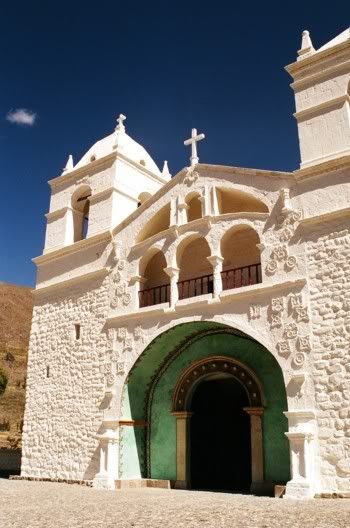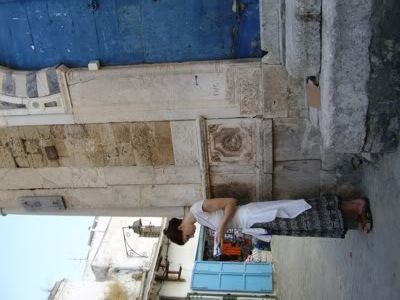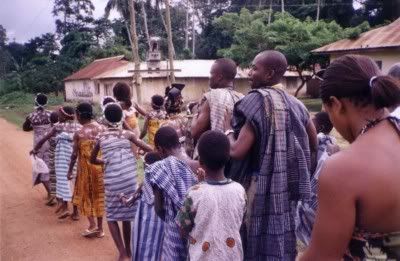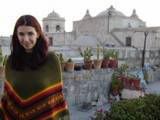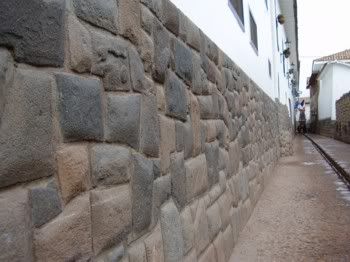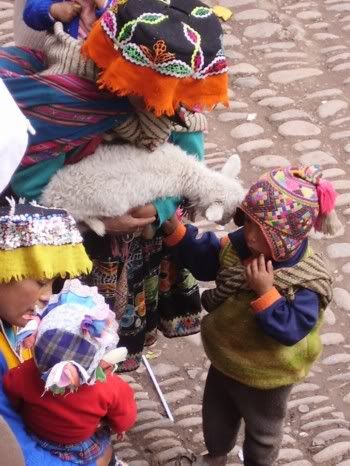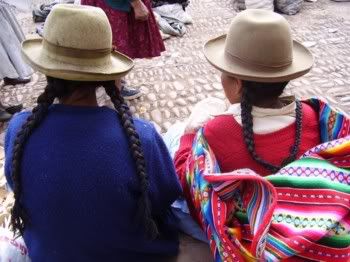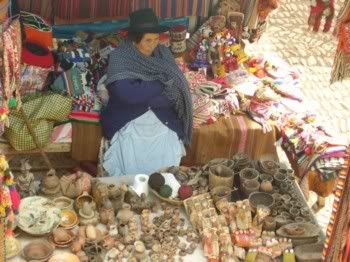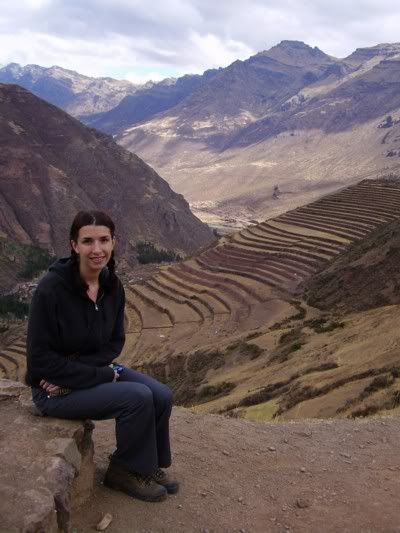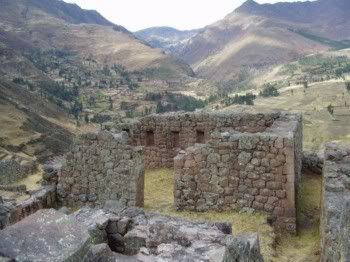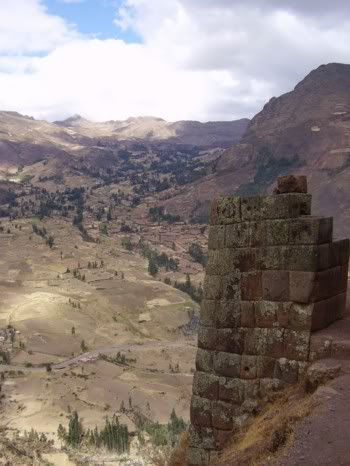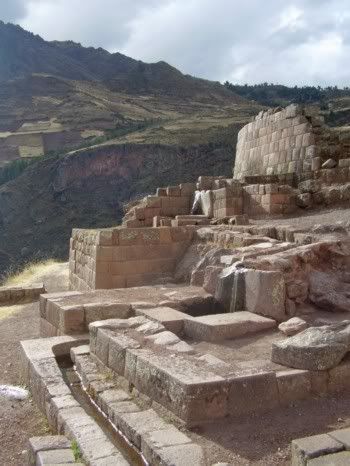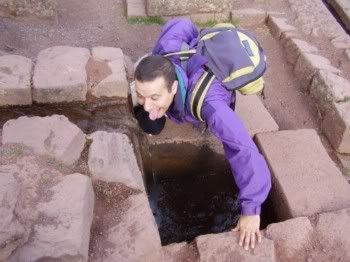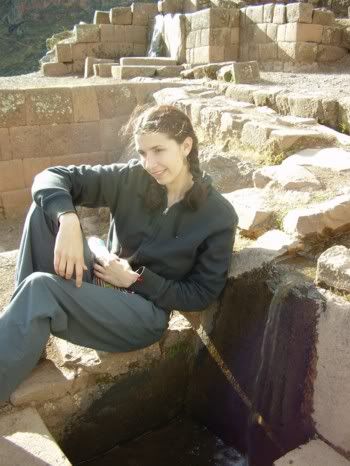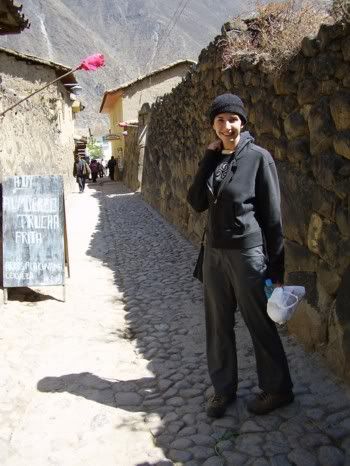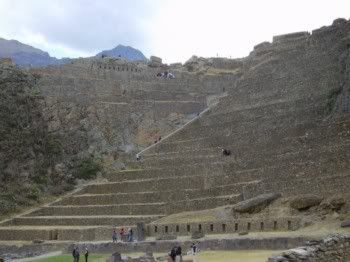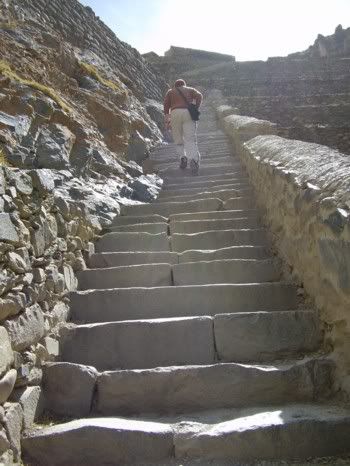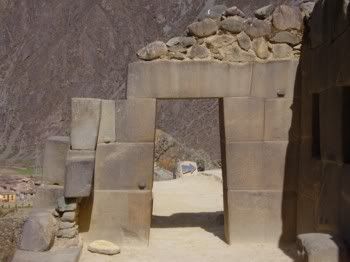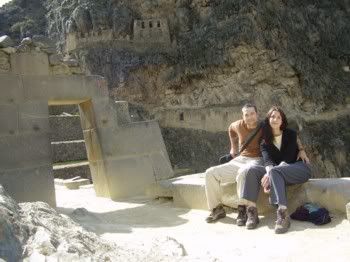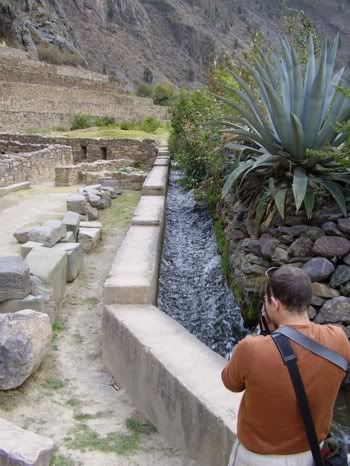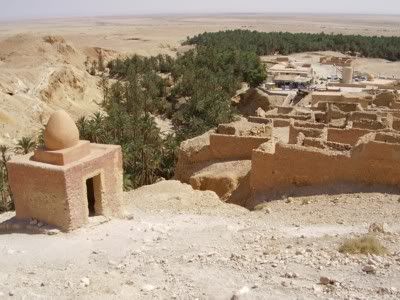 Dusty:Starlight:Culture
|
|
|
|
The Sacred Valley
2005-08-26 5:44 p.m. From my journal, sometime in early August. Too lazy to look at a calendar right now. The Sacred Valley "FIND YOUR CHI AT MACHU PICCHU" a sign screams out from a dusty wall of a small Israeli restaurant we happily stumbled upon in the old quarter of Cuzco. We have to chuckle at it, because there's so much about Cuzco, Aguas Calientes and other Machu-Pichhu-jumping-off-point towns that already scam as much money as possible out of tourists, and this series of new-agey tours (and their outrageous price tags) was just too much. We had been seeing the signs everywhere - go at night to Machu Picchu with a supposed curandero (hmmm, who drives a Volvo and wears Gap jeans and converse sneakers?), see the ruins through the lens of Ayahuasca, participate in ancient Inca ceremonies. I would giggle when I pictured huge groups of forty tourists - most likely to be German, Japanese or Australian young twenty-somethings thinking they're on a real adventure - tromping through the ruins and wondering why nothing was happening. Even creepier, sadder, and more hollow than the tours themselves: the burnt and weathered British (etc.) ex-pats who run them. I do indeed think Peru can be rough on a non-native who chooses to re-locate. Seems like after ten years or so in the country, you become as corrupt in your practices as the government. Maybe you have to just to keep your head above water. In any case, we have a long talk about what to do at this stage. We're a few days and a harrowing plane ride out of two weeks in the remote jungle; Steve's covered in mite bites, and though we think we've gotten most of the burrowing insects out of his body, he's still uncomfortable. I have (or had, the bed-ridden worst of it has subsided) symptoms akin to Dengue fever - non- hemorrhagic, of course, or I wouldn't be writing this right now - which makes sense since Puerto was just rampant with it this month. We both agree we might have to break down and a) take the meds we always bring on these trips but happily chuck once back home, never having to take them, and b) go to a local doctor, which is always a bit scary. But if we can put that off, why not! Nothing like denial. We had to come back here to Cuzco from Puerto Maldonado, because it's where the airport is, but we agreed that we certainly don't have to stay here. So we hop a combi for Pisac after walking around half of Cuzco trying to find the station. Our bags are tied down to a roof rack, and we squeeze onto a mini-bus, getting the last two seats. Given the low ceiling, and my desire to be able to write this now, I'm glad I didn't have to stand. I feel bad for the tall Irish girl at the front of the bus who didn't get on here in time to sit. The Peruvians don't have that problem at all. * Finally in Pisac, and Roger the Brit wasn't kidding when he said there isn't much here. It's refreshing, though, considering the amount of tourism in Cuzco, and the resulting scams and sometime Disney World-ish feel to the place. I think once we saw that fifth sign about spiritual tours, we just had to get away. But that's just capitalism, isn't it. We're in a tiny family hostel overlooking the town square, where a huge market sets up every Sunday to sell crafts, food, and just about anything you can imagine. The "crafts" part was added for the tourists twenty or so years ago, but this market itself is ancient - and is one of the biggest in this part of South America. Most tourists who come through this part of Peru don't stay here in Pisac; they instead pour in via tourist busses on a day trip. I can't imagine such a scene in this tiny place, so Steve and I decide to walk around the village today, and take a 30 cent bus to near by Urubamba tomorrow to take care of things like bank, groceries, plane tickets and Internet (there really is nothing here in Pisac but a church, a few restaurants, and a bottle store with a few live chickens and some pricey produce). When we return, we'll go to the ruins on the encircling mountains above, and hopefully avoid the crowds completely.
Mission Accomplished. By the time we got back in from Urubamba - where we met some very nice police officers, by the way, but that's another story entirely - most of the crowds were gone, and we picked through a few of the market stalls. I bought some wind-chimes for Nicole, and for Jen, and Steve found himself and Kris some great scarves and hats. We took a taxi halfway up the mountain after that, and hiked into (or should I say up to) the Pisac ruins. I know they're probably nothing compared to Machu Picchu, which we'll hopefully be at by next week, but they still took my breath away. There was a path leading up to the ruins to a certain point - and after the path, just steps, or rocks that have become flattened steps by all the traffic, after all these years. So the result is a slippery and dizzying trek to the top, at times along paths where the mountains edge will drop a sheer 500 feet below. About a thousand feet above the village, as well, it wasn't always easy to breathe, or to catch your breath, so we took our time and would sit for some periods before continuing on. It's free for locals to roam around the ruins, so we were met with two or three "guides" along the way who would point out the obvious ("That's Pisac, down below"; "Those are Inca ruins, just ahead") unsolicited, and then demand money for the "information" they'd provided. I'd seen the same attempts in Morocco years ago, and so I handled them in the same way: "GRACIAS, AMIGO!" Nothing more, nothing less. People get disappointed, but disarmed. I think they're expecting to either get money, or an angry scolding. The gratitude confuses for just enough time to briskly walk away. At the top of the mountain sat the temple of the sun, where a fountain and other irrigation channels still in use by the village below brought clean water down from the sharp, snow-covered peak above. It was beautiful, sparkling in the sunlight, and it felt like a Shangri-La oasis after we'd climbed the most difficult path, almost on hands and knees. Once down again, we treated ourselves to a nice dinner of lomo soltado and chicken something, with coca tea and fresh fruit for desert. Tomorrow it's Ollantaytambo, the site of a great battle between the Spanish and the natives, where the Inca almost completely held off their invaders because of their advantage of the mountains. * This morning in Pisac, we waited for a public combi to pass by on its way to Chinchero or something that might drop us off in Ollantaytambo. We of course had several taxi drivers approach us, saying that there is no combi that goes anywhere remotely near Ollantaytambo, and the only way to get there would be to take said driver's $10 (US!) taxi to the village instead. I was wishing I knew enough Spanish to say "So that bus is just a figment of my imagination?" when a Combi with CHINCHERO/OLLANTAYTAMBO painted on the windshield pulled up behind the emphatically gesturing taxi driver, but I don't, so we just walked around the driver and asked the Combi guys to take us where we needed to go. No problem, amigo, fifty cents for the two of us. I waved good-bye to the taxi guys out the bus window. Here, now, in Ollantaytambo, we met an unbelievably kind and articulate girl named Kathleen, who lives in Lima but works in the village during tourist season to help maintain the area. I'm still a bit ill, so she made me some kind of concoction of leaves and boiling water that aren't exactly tasty, but definitely have helped my symptoms. I tasted Eucalyptus, definitely - and it's cleared me out a bit. The other stuff, who knows - but if it tides me over while we're walking around the ruins here, great. We're going to have some yogurt and cheese (there's a market here, wahoo!), and then head up to the temple sites. * As beautiful a walk as Pisac, or perhaps more so, Ollantaytambo's ruins are more decidedly and obviously Inca - great square stones fitting into each other like jig-saw puzzle pieces, and trapezoidal doorways that are perfectly positioned toward the sun or moon at certain times of day, certain times of the year. But this village and these ruins, being higher up the mountain, were more sacred than those at Pisac, and perhaps for that reason more fiercely defended against the invading Spanish hundreds of years ago. It was another tough walk to get up here, but oddly easier than Pisac; I think my fever is subsiding and we're both re-acclimatizing. I'm sitting at the site now that were once hot-spring or mineral baths, but today and now are just small trickles of icy mountain water falling from smooth stone spouts. It must have been quite a sight, in its entirety; you can almost imagine what it looked like because so much of these complexes are so intact. We're lucky to see it now...I just hope the country's government can get it together soon enough to help preserve some of the remaining ruins around the area. The damage to some because of pedestrian traffic and/or neglect is heart breaking. We're going to descend back to the village in a few minutes and get some coffee at a little cafe that has a beautiful terrace on the main square, looking out at the mountains, these ruins, and the central market. It will feel good to just sit for a time, especially since in a day or two a train will pull out of the station here that will take us up to Aguas Calientes, and eventually Machu Picchu. I think we need to rest to be ready. * Pisac Market
Pisac Ruins
Ollantaytambo
Ollantaytambo Ruins
More Soon. xoxo |
||
